现代英语词汇学概论chapter2.
英语词汇学总结(细致)
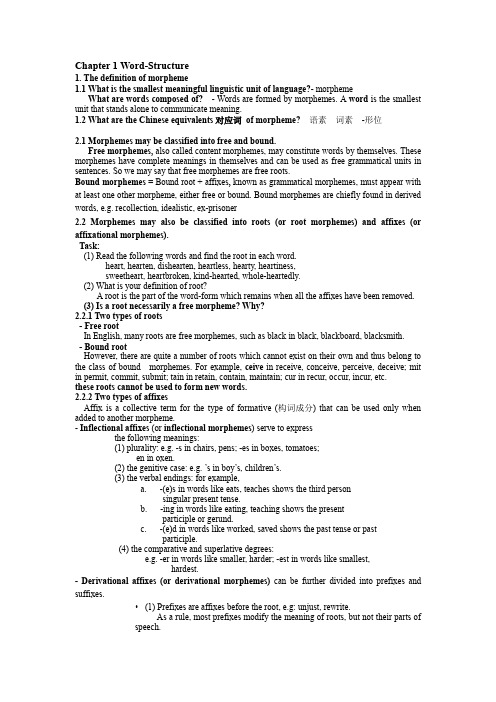
Chapter 1Word-Structure1. The definition of morpheme1.1 What is the smallest meaningful linguistic unit of language?- morphemeWhat are words composed of? - Words are formed by morphemes. A word is the smallest unit that stands alone to communicate meaning.1.2 What are the Chinese equivalents对应词of morpheme? 语素词素-形位2.1 Morphemes may be classified into free and bound.Free morphemes, also called content morphemes, may constitute words by themselves. These morphemes have complete meanings in themselves and can be used as free grammatical units in sentences. So we may say that free morphemes are free roots.Bound morphemes = Bound root + affixes, known as grammatical morphemes, must appear with at least one other morpheme, either free or bound. Bound morphemes are chiefly found in derived words, e.g. recollection, idealistic, ex-prisoner2.2 Morphemes may also be classified into roots (or root morphemes) and affixes (or affixational morphemes).Task:(1) Read the following words and find the root in each word.heart, hearten, dishearten, heartless, hearty, heartiness,sweetheart, heartbroken, kind-hearted, whole-heartedly.(2) What is your definition of root?A root is the part of the word-form which remains when all the affixes have been removed.(3) Is a root necessarily a free morpheme? Why?2.2.1 Two types of roots- Free rootIn English, many roots are free morphemes, such as black in black, blackboard, blacksmith.- Bound rootHowever, there are quite a number of roots which cannot exist on their own and thus belong to the class of bound morphemes. For example, ceive in receive, conceive, perceive, deceive; mit in permit, commit, submit; tain in retain, contain, maintain; cur in recur, occur, incur, etc.these roots cannot be used to form new words.2.2.2 Two types of affixesAffix is a collective term for the type of formative (构词成分) that can be used only when added to another morpheme.- Inflectional affixes (or inflectional morphemes) serve to expressthe following meanings:(1) plurality: e.g. -s in chairs, pens; -es in boxes, tomatoes;en in oxen.(2) the genitive case: e.g. ’s in boy’s, children’s.(3) the verbal endings: for example,a. -(e)s in words like eats, teaches shows the third personsingular present tense.b. -ing in words like eating, teaching shows the presentparticiple or gerund.c. -(e)d in words like worked, saved shows the past tense or pastparticiple.(4) the comparative and superlative degrees:e.g. -er in words like smaller, harder; -est in words like smallest,hardest.- Derivational affixes (or derivational morphemes)can be further divided into prefixes and suffixes.•(1) Prefixes are affixes before the root, e.g: unjust, rewrite.As a rule, most prefixes modify the meaning of roots, but not their parts of speech.task: list some prefixes that can modify the parts of speech.- en-(em-) as in words like embody, enrich- be- as in words like befriend, belittle- a- as in words like asleep, aside • (2) Suffixes are affixes after the root, e.g.: darkness, worker. By the addition of the suffix,the word is usually changed from one part ofspeech into another, e.g. liberation, modernize.2.3 Relationship between the two classifications of morphemesMorphemeIt is the minimal meaningful unit of language. Or it is the smallest functioning unit in the composition of words.a) Bound morphemes are morphemes which alone can be used as words .What is an allomorph?An allomorph is one of the variants of the same morpheme.语素/形位变体是同一个语素的不同形式。
《现代英语词汇学概论》----解析汇报(张韵斐)
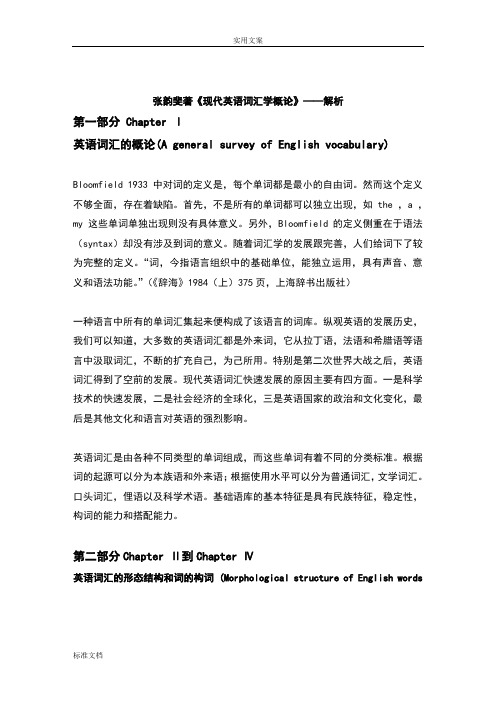
张韵斐著《现代英语词汇学概论》——解析第一部分 Chapter Ⅰ英语词汇的概论(A general survey of English vocabulary)Bloomfield 1933 中对词的定义是,每个单词都是最小的自由词。
然而这个定义不够全面,存在着缺陷。
首先,不是所有的单词都可以独立出现,如 the ,a ,my 这些单词单独出现则没有具体意义。
另外,Bloomfield的定义侧重在于语法(syntax)却没有涉及到词的意义。
随着词汇学的发展跟完善,人们给词下了较为完整的定义。
“词,今指语言组织中的基础单位,能独立运用,具有声音、意义和语法功能。
”(《辞海》1984(上)375页,上海辞书出版社)一种语言中所有的单词汇集起来便构成了该语言的词库。
纵观英语的发展历史,我们可以知道,大多数的英语词汇都是外来词,它从拉丁语,法语和希腊语等语言中汲取词汇,不断的扩充自己,为己所用。
特别是第二次世界大战之后,英语词汇得到了空前的发展。
现代英语词汇快速发展的原因主要有四方面。
一是科学技术的快速发展,二是社会经济的全球化,三是英语国家的政治和文化变化,最后是其他文化和语言对英语的强烈影响。
英语词汇是由各种不同类型的单词组成,而这些单词有着不同的分类标准。
根据词的起源可以分为本族语和外来语;根据使用水平可以分为普通词汇,文学词汇。
口头词汇,俚语以及科学术语。
基础语库的基本特征是具有民族特征,稳定性,构词的能力和搭配能力。
第二部分Chapter Ⅱ到Chapter Ⅳ英语词汇的形态结构和词的构词 (Morphological structure of English wordsand word-formation )(一)词素(Morphemes)单词是有词素(morphemes)构成的。
词素即英语语言中有意义的最小单位,同时具有声音和意义。
单词可以有一个或一个以上的词素组成。
如:nation 是一个词素,national有nation+al 两个词素。
现代英语词汇学概论chapter2

3
2.1 Morphemes
• The morpheme is the smallest meaningful linguistic unit of language, not divisible or analyzable into smaller forms. • The morpheme denotes the smallest units or the minimum distinctive feature of some class of things. • A morpheme is also two-facet language unit which possesses both sound and meaning.
• • • • One morpheme: nation Two morphemes: nation-al Three morphemes: nation-al-ize Four morphemes: de-nation-al-ize
4
2.2 Allomorphs
An allomorph (词/语素变体)
SUMMARY
15
Review: about the morpheme
Give the English or Chinese for the following and explain.
博客 闪客 奇客/极客 维客 威客
blog flash geek wiki witkey
黑客/骇客 掘客 沃客 播客 搞客
– Affixes are forms that are attached to words or word elements to modify meaning or function.
英语词汇学第二章词素

can stand alone as words and also combine with other themes to form new words, carrying both legal and quantitative graphical means (e.g., "cat," "run,"
目录
• Composition and Characteristics of Compound Words
• Abbreviations and acronyms • Summary, Review, and Extension
01
Basic Concepts and Classification of Morphemes
The role of derivative relationships in word formation
01
02
03
04
05
Definition: Derivative relationships involve the creation of new words from existing words through the addition of prefixes, suffixes, or other modifications
Comparative analysis of the similarities and differences between the two
01
Similarities
02
Both conflicting changes and derivative relationshrms
Prefixes, infixes, and suffixes
现代英语词汇学概论第一章汉语版
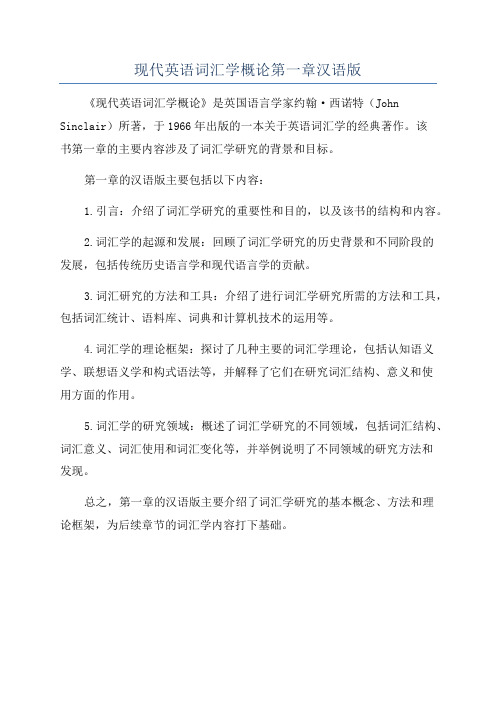
现代英语词汇学概论第一章汉语版
《现代英语词汇学概论》是英国语言学家约翰·西诺特(John Sinclair)所著,于1966年出版的一本关于英语词汇学的经典著作。
该
书第一章的主要内容涉及了词汇学研究的背景和目标。
第一章的汉语版主要包括以下内容:
1.引言:介绍了词汇学研究的重要性和目的,以及该书的结构和内容。
2.词汇学的起源和发展:回顾了词汇学研究的历史背景和不同阶段的
发展,包括传统历史语言学和现代语言学的贡献。
3.词汇研究的方法和工具:介绍了进行词汇学研究所需的方法和工具,包括词汇统计、语料库、词典和计算机技术的运用等。
4.词汇学的理论框架:探讨了几种主要的词汇学理论,包括认知语义学、联想语义学和构式语法等,并解释了它们在研究词汇结构、意义和使
用方面的作用。
5.词汇学的研究领域:概述了词汇学研究的不同领域,包括词汇结构、词汇意义、词汇使用和词汇变化等,并举例说明了不同领域的研究方法和
发现。
总之,第一章的汉语版主要介绍了词汇学研究的基本概念、方法和理
论框架,为后续章节的词汇学内容打下基础。
现代英语词汇学概论复习(Chapter1-10)
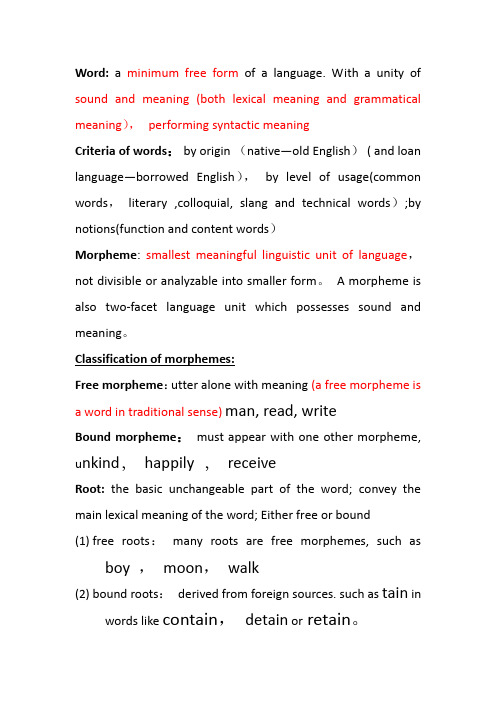
Word: a minimum free form of a language. With a unity of sound and meaning (both lexical meaning and grammatical meaning),performing syntactic meaningCriteria of words:by origin (native—old English)( and loan language—borrowed English),by level of usage(common words,literary ,colloquial, slang and technical words);by notions(function and content words)Morpheme: smallest meaningful linguistic unit of language,not divisible or analyzable into smaller form。
A morpheme is also two-facet language unit which possesses sound and meaning。
Classification of morphemes:Free morpheme:utter alone with meaning (a free morpheme is a word in traditional sense) man, read, writeBound morpheme:must appear with one other morpheme, u nkind,happily ,receiveRoot:the basic unchangeable part of the word; convey the main lexical meaning of the word; Either free or bound(1)free roots:many roots are free morphemes, such asboy ,moon,walk(2)bound roots:derived from foreign sources. such as tain inwords like contain,detain or retain。
《现代英语词汇学概论》----解析汇报(张韵斐)

张韵斐著《现代英语词汇学概论》一一解析第一部分Chapter I英语词汇的概论(A general survey of English vocabulary)Bloomfield 1933 中对词的定义是,每个单词都是最小的自由词。
然而这个定义不够全面,存在着缺陷。
首先,不是所有的单词都可以独立出现,如the , a , my这些单词单独出现则没有具体意义。
另外,Bloomfield 的定义侧重在于语法(syntax )却没有涉及到词的意义。
随着词汇学的发展跟完善,人们给词下了较为完整的定义。
“词,今指语言组织中的基础单位,能独立运用,具有声音、意义和语法功能。
”(《辞海》1984 (上) 375页,上海辞书出版社)一种语言中所有的单词汇集起来便构成了该语言的词库。
纵观英语的发展历史,我们可以知道,大多数的英语词汇都是外来词,它从拉丁语,法语和希腊语等语言中汲取词汇,不断的扩充自己,为己所用。
特别是第二次世界大战之后,英语词汇得到了空前的发展。
现代英语词汇快速发展的原因主要有四方面。
一是科学技术的快速发展,二是社会经济的全球化,三是英语国家的政治和文化变化,最后是其他文化和语言对英语的强烈影响。
英语词汇是由各种不同类型的单词组成,而这些单词有着不同的分类标准。
根据词的起源可以分为本族语和外来语;根据使用水平可以分为普通词汇,文学词汇。
口头词汇,俚语以及科学术语。
基础语库的基本特征是具有民族特征,稳定性,构词的能力和搭配能力。
第二部分Chapter H 到Chapter IV英语词汇的形态结构和词的构词(Morphological structure of Englishwords and word-formati on )(一) 词素(Morphemes )单词是有词素(morphemes )构成的。
词素即英语语言中有意义的最小单位,同时具有声音和意义。
单词可以有一个或一个以上的词素组成。
如:n ati on是一个词素,national 有nation+al 两个词素。
现代英语词汇学概论

subject (aux+) verb complement 1 The criminal should come clean. 2. George would get even with the adjective gang phrase 3. The company went broke. 4. The schedule has gone haywire. Noun phrase
Introductory Remarks
• Definition: An English idiom is a group of words with a special meaning different from the meaning of its constituent words. In another word, An idiom is a fixed group of words or a single word, or even a sentence, with a special meaning that cannot be guessed from its structure. It is an established form, one that has been accepted by traditional usage . As such, the component words, word order and meaning of each idiom should be learned as a whole.
英语词汇学课件Chapter 2

CHAPTER 21. It is assumed that the world has about ___________ languages.A. 3000B. 2000C. 1000D.40002. It is assumed that the world has approximately 3000 (some put it 5000) languages, which can be grouped into roughly ___________ language families on the basis of similarities in their basic word stock and grammar.A. 500B. 4000C. 300D.20003. The Indo-European Language Family accordingly fall into ___________ principle groups, which can be grouped into an Eastern set and Western set.A. eightB. sixC. fiveD. several4. In the Eastern set, ___________ and ___________ are each the only modern language respectively.A. Italic; GermanicB. Armenian; AlbanianC. Celtic; HellenicD. Balto-Slavic; Indo-Iranian5. The following words are derived from the dead language Sanskrit except ___________.A. PersianB. BengaliC. HindiD. Romany6. All these languages have some influence on English to a greater or lesser extent because each has ___________ the English vocabulary.A. borrowed words fromB. enlarged words toC. decreased words toD. lent words into7. We find the following languages in the Celtic except ___________.A. ScottishB. IrishC. DanishD. Breton8. The Balto-Slavic comprises such modern languages as Prussian, Lithuanian, Polish, Czech, Bulgarian, Slovenian and ___________.A. GreekB. RomanC. IndianD. Russian9. Indo-Iranian comprises the modern language except ___________.A. PersianB. BengaliC. Hindi, RomanyD. Polish10. The five Romance languages, namely, Portuguese, Spanish, French, Italian, Romanian all belong to the Italic through an intermediate language called ___________.A. SanskritB. LatinC. CelticD. Anglo-Saxon11. The first peoples known to inhabit England were ___________.A. CeltsB. RomansC. Anglo-SaxonsD. Jutes12. Which of the following is not included in the Germanic tribes?A. Angles.B. Celtic.C. Saxons.D. Jutes.13. Some foreign languages have impact on old English except ___________.A. FrenchB. LatinC. NorwegianD. Danish14. After the ___________, the Germanic tribes called Angles, Saxons, and Jutes came in great numbers.A. GreeksB. IndiansC. RomansD. French15. As a result, Celtic made only a ___________ contribution to the English vocabulary.A. smallB. bigC. greatD. smaller16. The introduction of ___________ at the end of the 6th century had a great impact on the English vocabulary.A. printingB. ChristianityC. French wordsD. all the above17. After the invading Germanic tribes settled down in Britain, their language almost totally blotted out the ___________.A. Old EnglishB. Middle EnglishC. Anglo-SaxonD. Celtic18. Old English has a vocabulary of about ___________ words.A. 30000 to 40000B. 40000 to 50000C. 50000 to 60000D. 60000 to 7000019. It is estimated that at least ___________ words of Scandinavian origin have survived in modern English.A. 1200B. 800C. 900D. 100020. Which of the following is not Scandinavian origin?A. Skirt.B. Alter.C. Their.D. Birth.21. The ___________ family consists of the four Northern European Languages: Norwegian, Icelandic, Danish and Swedish, which are generally known as Scandinavian languages.A. GermanicB. Indo-EuropeanC. AlbanianD. Hellenic22. Old English vocabulary was essentially ___________ with a number of borrowings from Latin and Scandinavian.A. ItalicB. GermanicC. CelticD. Hellenic23. The Norman Conquest in 1066 introduced a large number of words into the English vocabulary.A. FrenchB. GreekC. DanishD. Latin24. In the 9th century the land was invaded again by Norwegian and Danish Vikings. With the invaders, many ___________ words came into the English language.A. GreekB. RomanC. CelticD. Scandinavian25. Which of the following is NOT true about Old English?A. Users of Old English borrowed heavily from Latin and other languages.B. Old English has a vocabulary of about 50000 to 60000.C. Old English refers to the English language used from 450 to 1150.D. Old English was a highly inflected language.26. Identify the word that ___________ is of Scandinavian origin among the following.A. skirtB. dressC. modelD. status27. The Norman Conquest started a continual flow of French words into English ___________ of them are still in use today.A. Eighty-five percentB. Fifty-six percentC. Seventy-two percentD. Seventy-five percent28. By the end of the ___________ century, virtually all of the people who held political or social power and many of those in powerful Church positions were of Norman French origin.A. 10thB. 11thC. 12thD. 13th29. Modern English began with the establishment of ___________ in England.A. printingB. Bourgeois RevolutionC. Industrial RevolutionD. the Renaissance30. Considering the changes in ___________, we regard the year of ___________ as the divison line of Early and Late Modern English.A. grammar; 1600B. grammar; 1700C. vocabulary; 1600D. vocabulary; 170031. Since the beginning of the 20th century, ___________ has become even more important for the expansion of English vocabulary.A. word-formationB. borrowingC. semantic changeD. both B and C32. Which of the following is NOT one of the main sources of new words?A. The rapid development of modern science and technology.B. Geographical and political changes.C. The influence of other cultures and languages.D. Social and economic changes.33. Social, economic and political changes bring about such new words as the followings EXCEPT ___________.A. kungfuB. TV dinnerC. fast foodD. Watergate34. The modes of modern English vocabulary grow through three major channels: ___________, semantic change, ___________.A. exchange; lendingB. derivation; borrowingC. creation; borrowingD. affixation; creation35. In modern times, ___________ is the most important way of vocabulary expansion.A. creationB. semantic changeC. borrowingD. reviving archaic or obsolete words36. ___________ has played a vital role in the development of vocabulary, particularly in earlier times.A. creationB. semantic changeC. borrowingD. obsolete words37. Which of the following is one of the three channels through which modern English vocabularydevelops?A. Acronym.B. Blending.C. Elevation.D. Borrowing.38. ___________ means an old form which takes on a new meaning to meet the new need.A. CreationB. Semantic changeC. BorrowingD. Derivation39. The word of "recollection" is formed by ___________.A. creationB. semantic changeC. borrowingD. collocation40. It is assumed that the world has 3 000 languages, which can be grouped into roughly ___________ language families on the basis of similarities in their basic word stock and grammar. A. 200 B. 300C. 400D. 50041. The following languages all belong to the Eastern set except___________.A. Balto-SlavicB. Indo-IranianC. ArmenianD. Italic42. In the Eastern set, Armenian and___________ are the sole modern languages in two respective families.A. AlbanianB. RussianC. SlovenianD. Lithuanian43. Which language does not belong to the Italic?A. Portuguese.B. Spanish.C. Welsh.D. French.44. The early inhabitants of the British Isles spoke___________.A. EnglishB. CelticC. ScandinavianD. Hellenic45. The Germanic speakers took permanent control of the land that was later called___________ (the land of Angles).A. GermanB. GreeceC. EnglandD. American46. Old English has a vocabulary of about 50 000 to 60 000words, which is entirely Germanic with only a few borrowings from___________ and Scandinavian.A. LatinB. GreekC. CelticD. French47. The influx of French words into English did not occur until after___________.A. 1200B. 1300C. 1400D. 150048. In the Middle English period, the three main dialects of the land were Northern, ___________ and Midland.A. EasternB. WesternC. SouthernD. Oriental49. ___________ is the chief ancestor of Modern English, not Southern.A. EasternB. WesternC. NorthernD. Midland50. The Norman Conquest started a continual flow of___________ words into English.A. LatinB. GreekC. DanishD. French51. Midland is an ___________ dialect, as its name implies, and intelligible to Northerners and Southerners alike.A. middleB. intermediateC. interchangeableD. internal52. The number of ___________ words that poured into English was unbelievably great and covered every realm of culture and society in the Middle English period.A. FrenchB. GermanC. LatinD. Russian53. Before English regained social status in Middle English period, those in power spoke French; those who were literate read and wrote ___________; those who could educate their children taught them in ___________; and any young man who sought to earn his living as a scribe learned ___________or ___________.A. Latin; French; Latin; FrenchB. French; French; French; EnglishC. French; French; Latin; FrenchD. Greek; French; Greek; French54. In the early period of Modern English, Europe saw a new upsurge in learning ancient Greek and Roman classics, which is known in history as the ___________.A. RenewalB. RevivalC. ReboundD. Renaissance55. Since the beginning of the 20th century, particularly after World War II, although borrowing remains a channel of English vocabulary expansion, more words are created by ___________.A. analogyB. word-formationC. transferD. conversion56. The Anglo-Saxon in the Old English period was almost a "___________" language, which created new words from its own compound elements with few foreign words.A. uniqueB. fashionC. pureD. old57. As one scholar notes, old English was characterized by " ___________ endings", Middle English by "leveled endings", and Modern English by " ___________ endings".A. full; lostB. lost; fullC. full; pureD. pure; lost58. Old English which was a ___________ language has evolved to the present language.A. analytic; syntheticB. synthetic; analyticC. agglutinative; analyticD. isolating; synthetic59. Of all the foreign languages from which we have borrowed words, Latin, Greek, French, and ___________ stand out as the major contributors.A. ItalianB. GermanC. DutchD. Scandinavian60. In the Pre-Anglo-Saxon period, the words borrowed naturally from Latin reflected the new conceptions and experience in ___________ and ___________.A. war; economyB. economy; agricultureC. war; place namesD. war; agriculture61. In the Old English period, borrowings from Latin came in because of the introduction of Christianity, such as, ___________ and ___________.A. cook; candleB. shrine; sackC. candle; shrineD. mass; circle62. The ___________ centuries were especially prolific in Latin borrowings under the influence of Renaissance.A. 12th and 13thB. 13th and 14thC. 14th and 15thD. 15th and 16th63. Some late borrowings from Latin still retain their Latin forms. Which of the following was borrowed in the Modern English period?A. Frustrate.B. Focus.C. Logic.D. Trade.64. Which of the following does not come from Greek?A. Piano.B. Synonym.C. Philosophy.D. Lexicology.65. Typhoon is from ___________ and tatami is from ___________.A. Chinese; AfricanB. Chinese; JapaneseC. Arabic; TurkishD. Malay; Japanese66. Modern English vocabulary develops through ___________.A. terminology, analogy and borrowingB. creation* semantic change and borrowingC. creation, archaisms and semantic changeD. semantic change, denizens and argot67. Which of the following contemporary English vocabulary is from the rapid growth of science and technology?A. Fallout.B. Pant suit.C. Black belt.D. Mao jackets.68. The Scandinavian languages: Norwegian* Swedish, Danish and Icelandic, constitute the ___________ branch of the Germanic group.A. easternB. westernC. northernD. southern69. Reviving archaic or ___________ words also contributes to the growth of English vocabulary though insignificant.A. obsoleteB. oldC. usedD. ancient70. It is assumed that the world has about ___________ languages.A. 3,000B. 2,000C. 1,000D. 4,00071. All languages can be grouped into roughly ___________ language families on the basis of similarities in their basic word stock and grammar.A. 200B. 300C. 400D. 50072. The Indo-European language family is made up of most of the languages in the following places except ___________.A. EuropeB. the Near EastC. IndiaD. Africa73. The prehistoric Indo-European parent language is thought to be a highly ___________ language.A. developedB. advancedC. inflectedD. complicated74. In the western set of the Indo-European language family, Greek is the modern language derived from ___________.A. HellenicB. CelticC. SpanishD. Dutch75. We find the following languages in the Celtic except ___________.A. ScottishB. IrishC. DanishD. Breton76. The first peoples known to inhabit on British Isles were ___________.A. RomansB. GermansC. CeltsD. Saxons77. Now people generally refer to ___________ as old English.A. Anglo-SaxonB. CelticC. LatinD. Armenian78. Which of the following is not included in the Germanic tribes?A. AnglesB. CelticC. SaxonsD. Jutes79. Old English has a vocabulary of about ___________ words.A. 40,000 to 50,000B. 50,000 to 60,000C. 60,000 to 70,000D. 30,000 to 40,00080. Old English refers to the language used between ___________ and ___________.A. 410, 1150B.450, 1150C. 410, 1100D.450, 110081. Some foreign languages have impact on old English except ___________.A. FrenchB. LatinC. NorwegianD. Danish82. It is estimated that at least ___________ words of Scandinavian origin have survived in Modern English.A. 1,200B. 800C. 900D. 1,00083. Which of the following is not Scandinavian origin?A. skirtB. alterC. theirD. birth84. Until 1066, the influence on English was mainly ___________.A. LatinB. FrenchC. GermanicD. Celtic85. After the Norman Conquest a continual flow of ___________ words into English.A. LatinB. FrenchC. GermanicD. Celtic86. Between 1250 and 1500, about ___________ words of French origin poured into English.A. 7,000B. 6,000C. 9,000D. 10,00087. ___________ of the words of French origin are still in use today.A. Eighty-five percentB. Fifty-six percentC. Seventy-two percentD. Seventy-five percent88. As many as 2, 500 words of ___________ origin found their way into Middle English.A. DutchB. FrenchC. LatinD. Celtic89. Modern English began with the establishment of ___________ in England.A. printingB. Bourgeois RevolutionC. Industrial RevolutionD. Renaissance Time90. Modern English began in ___________.A. 1700B. 1066C. 1500D. 190091. Considering the changes in ___________ Early and Late Modem English.A. grammar, 1600B. grammar, 1700C. vocabulary, 1600D. vocabulary, 170092. Modern English is considered to be a/an ___________ language.A. inflectedB. analyticC. syntheticD. new93. Generally, the number of the present day English vocabulary is about ___________.A. two millionB. three millionC. one millionD. four million94. Modern English vocabulary develops through ___________.A. creationB. semantic changeC. borrowingD. all the above95. ___________ is not the reason of growth of present-day English vocabulary.A. The rapid development of modern science and technologyB. Social, economic and political changesC. The efforts of linguistsD. The influence of other cultures and languages96. Modern English vocabulary develops through three channels: ___________, semantic change and ___________.A. exchange, conversionB. compounding, borrowingC. creation, borrowingD. suffixation, creation97. ___________ is the most important way of vocabulary expansion.A. CreationB. Semantic changeC. BorrowingD. Meaning change98. ___________ means an old form which takes on a new meaning to meet the new need.A. CreationB. Semantic changeC. BorrowingD. Derivation99. The word of "recollection" is formed by ___________.A. creationB. semantic changeC. borrowingD. collocation100. Modern English vocabulary develops through three channels: ___________.A. creation, conversion and borrowingB. creation, borrowing and back-formationC. creation, semantic change and borrowingD. semantic change, borrowing and back-formation101. The Norman Conquest in 1066 introduced a large number of ___________ words into the English vocabulary.A. FrenchB. GreekC. DanishD. Latin102. The introduction of ___________ had a great impact on the English vocabulary.A. HinduismB. ChristianityC. BuddhismD. Islam103. After the ___________, the Germanic tribes called Angles, Saxons, and Jutes came in great numbers.A. GreeksB. IndiansC. RomansD. French104. After the invading Germanic tribes settled down in Britain, their language almost totally blotted out the ___________.A. Old EnglishB. Middle EnglishC. Anglo-SaxonD. Celtic105. Between 1250 and 1500 about ___________ words of French origin poured into English.A. 9,000B. 900C. 10,000D. 20,000106. Since the beginning of the 20th century, ___________ has become even more important for the expansion of English vocabulary.A. word-formationB. creationC. semantic changeD. both B and C107. The prehistoric Indo-European parent language is thought to be a highly language.A. inflectedB. derivedC. developedD. analyzed108. The five Romance languages, namely, Portuguese, Spanish, French, Italian, Romanian all belong to the Italic through an intermediate language called ___________.A. SanskritB. LatinC. CelticD. Anglo-Saxon109. By the end of the ___________ century, English gradually came back into the schools, the law courts, and government and regained social status.A. 12thB. 13thC. 14thD. 15th1. The prehistoric Indo-European parent language is thought to be a highly ___________ language.2. As the invading tribes took over and settled in Britain, the Celtic languages gradually ___________.3. The surviving languages show various degrees of ___________ to one another.4. The surviving languages accordingly fall into eight principal groups, which can be grouped into an Eastern set: Balto-Slavic, Indo-Iranian, Armenian and Albanian; a Western set: Celtic, Italic, Hellenic, ___________.5. Scandinavian language refers to Icelandic, Norwegian, Danish and ___________.6. After the Romans, the Germanic tribes came in great numbers. Soon they took___________ control of the land, which was to be called England.7. Augustine came to spread ___________ in Britain at the end of the 6th century.8. Now people generally refer to Anglo-Saxon as ___________.9. In the 9th century the land was ___________ again by Norwegian and Danish Vikings.10. Middle English lasted for more than three hundred years from ___________ to ___________.11. The four major foreign contributors to English vocabulary in earlier times are Latin, French, Scandinavian and ___________.12. By the end of the eleventh century, ___________ all of the people who held political or social power and many of those in powerful church positions were of Norman French origin.13. The English words "power", "crime" are derived from ___________.14. Modern English began with the ___________ of printing in England.15. In the early period of Modern English, Europe saw a new upsurge of learning ancient and Roman classics. This is known in history as the ___________.16. It is necessary to subdivide Modern English into Early (1500 -1700) and ___________ Modem English.17. If we say that Old English was a language of full endings, Middle English was one of ___________.18. It can be concluded that English has evoked from a synthetic language (Old English) to the present ___________ language.19. The rapid development of ___________ and ___________ contributes a lot to the vocabulary development.20. ___________ refers to the formation of new words by using the existing materials, namely roots, ___________ and other elements.21. There're three modes of vocabulary development; creation, ___________ and borrowing.22. World languages can be grouped into roughly ___________ language families on the basis of similarities in the basic word stock and grammar.23. The surviving languages accordingly fall into ___________ principal groups, which can be grouped into an Eastern set and a Western set.24. Scandinavian language refers to Icelandic, Norwegian, Danish and ___________.25. Old English was the combination of three ___________ dialects which were used between ___________ and 1150.26. Old English was a highly ___________ language just like modern German.27. Old English has a vocabulary of about ___________ to ___________ words.28. Middle English lasted for more than three hundred years from ___________ to ___________.29. The four major foreign contributors to English vocabulary in earlier times are Latin, French, Scandinavian and ___________.30. The English words "power”, "crime" are derived from ___________.31. The introduction of ___________ into England marked the beginning of modem English period.32. Modern English began with the establishment of printing in England, and it can be subdivided into stages.33. Modern English is a ___________ language.34. The rapid development of ___________ and ___________ contributes a lot to the vocabulary development.35. ___________ refers to the formation of new words by using the existing materials, namely roots, ___________ and other elements.36. There’re three modes of vocabulary development: creation, ___________ and borrowing.37. It is necessary to subdivide Modern English into Early (1500 - 1700) and ___________ Modern English.38. The language used in England between 450 and 1150 is called ___________.39. If we say that Old English was a language of full endings, Middle English was one of ___________.40. The surviving languages accordingly fall into eight principal groups, which can be grouped into an Eastern set: Balto-Slavic, Indo-Iranian, Armenian and Albanian; a Western set: Celtic, Italic, Hellenic, ___________.41. It can be concluded that English has evolved from a synthetic language (Old English) to the present ___________ language.42. Now people generally refer to ___________ as Old English.43. The language used between 450 and ___________ is called ___________, which has a vocabulary of ___________. Middle English refers to the language spoken from 1150 to ___________. Followed by the ___________ period, subdivided as early modern English (___________) and late ___________ (1700-up to now).( ) 1. English is more closely related to German than French.( ) 2. Scandinavian languages refer to Icelandic, Norwegian, Danish and Swedish.( ) 3. Old English was a highly inflected language.( ) 4. In early Middle English period, English, Latin and Celtic existed side by side.( ) 5.The introduction of printing into England marked the beginning of Modern English period. ( ) 6. Modern English is considered to be an analytic language.( ) 7. The four major foreign contributors to English vocabulary in earlier times are Latin, French, Scandinavian and Italian.( ) 8. In modern times, borrowing brings less than ten percent of modern English vocabulary. ( ) 9. The three major factors that promote the growth of modern English vocabulary are advances in science and technology* influence of foreign cultures and languages.( ) 10. The most important mode of vocabulary development in present-day English is creation of new words by means of word-formation.( ) 11. Old English vocabulary was in essence Germanic with a small quantity of words borrowed from Latin and Scandinavian.( ) 12. Middle English absorbed a tremendous number of foreign words but with little change in word endings.( ) 13. Old English refers to the language used between 100 and 450.( ) 14. We refer to Celtic as old English.( ) 15. Words of old English had full endings.( ) 16. In 55 B. C. -54 B. C., the Romans invaded the British Isles and were to occupy the land until about 410.( ) 17. Celtic made only a small contribution to the English vocabulary.( ) 18. Many religious terms such as abbot, candle, alter, amen were brought into English by Latin-speaking Roman missionaries.( ) 19. Middle English lasted for more than four hundred years.( ) 20. During the Middle English period, Celtic, Latin and English existed side by side.( ) 21. During early Middle English period, Norman French became the polite speech while native tongue was a despised language.( ) 22. Middle English was a language of full endings.( ) 23. Modern English is a synthetic language.( ) 24. After World War II, thousands of new words have been created to express new ideas, inventions and scientific achievements.( ) 25. The influence of other cultures and languages is one of the main sources of new words. ( ) 26. Semantic change is the most important way of vocabulary expansion.( ) 27. In the vocabulary development, some old words fell out of use.( ) 28. The introduction of printing into England by William Caxton marked the beginning of Middle English period.( ) 29. Historically speaking, American English is older than British English.( ) 30. The Norman Conquest virtually introduced French-English bilingualism into Britain. ( ) 31. The late Modern English period is characterized by the complete loss of endings.1.What are the main sources of new words?2. What are the features of Old English, Middle English and Modern English? What changes has English undergone as far as inflection is concerned?3. What are the reasons for the growth of contemporary English vocabulary?。
词汇学Chapter-2-the development of the English vocabulary

2.1 Indo-European Language Family
Eastern Set
Western Set Celtic Italic Hellenic Germanic
Indo-Iranian Balto-Slavic Armenian Albanian
2.1 The Indo-European Language Family
1. Hellenic希腊语族 ➢ Greek
2. Celtic凯尔特语族 ➢ Scotish苏格兰语 ➢ Irish爱尔兰语 ➢ Welsh威尔士 ➢ Breton布列塔尼语 ➢ Pictish皮克特语
3. Hittite希泰语族 4. Tocharian吐火罗语族
Norwegian挪威语
Icelandic冰岛语
➢ Scandinavian languages
Swedish瑞典语
Three periods of development
➢Old English/AngloSaxon English (449-1150 AD)
➢Middle English (1100-1500AD)
➢Modern English (1500-present)
➢ Russian俄罗斯语
2. Indo-Iranian印伊语族 ➢ Persian波斯语 ➢ Bengali 孟加拉语 ➢ Hindi 北印度语 ➢ Romany吉普赛语
3. Armenian亚美尼亚语族 ➢ Armenian
4. Albanian阿尔巴尼语族 ➢ Albanian
The Western Set
The first peoples known to inhabit the land were Celts.
自考英语词汇学 第二章课件

In fact, more than twenty-five percent of modern English words come almost directly from classical languages. 事实上,现代英语词汇 中有 25%以上几乎是直接从古典语言中直接介入的 (WBD)。 In modern English, word endings were mostly lost with just a few exceptions. It can be concluded that English has evolved from a synthetic language (Old English) to the present analytic language.在现代英语中,除了少数几个 词之外,词尾几乎都消失了。可以这样说,英语已 从古英语的综合型语言发展成了现在的分析型语言 。
2
- The Indo-European is one of them. It is made up of most of the languages of Europe, the Near East, and India. 印欧 语就是其中之一。该语系包括欧洲的大多数 语言、近东诸语言和古梵语。
2.2.2 Middle English (1150-1500) -中古英语 Although there were borrowings from Latin, the influence on English was mainly Germanic. 虽然英语也从拉丁语中借词,但影响英语的主要还 是日耳曼语。 Between 1250 and 1500 about 9000 words of French origin poured into English. Seventy-five percent of them are still in use today.从 1250 年 到 1500 年的 250 年间,大约有 9000 个法语词汇 进入到英语中,其中 75%仍在使用。 If we say that Old English was a language of full endings. Middle English was one of leveled endings. 如果说古英语是全词尾的话,那么中古英 语的词尾已去了一半
大学英语词汇学Chapter 2 Word Formation II

4.1.2 Suffixation: the formation of words by adding suffixes to stems 1. Noun suffixes
1) Denominal nouns -Concrete: -eer, -er, -ess, -ette,-let -Abstract: -age,-dom,-ery, -hood, -ism, -ship 2) Deverbal nouns -denoting people: -ant, -ee, -ent, -er(-or) -denoting action, result, process, state: -age, -al, -ance, -tion, -ence,-ing, -ment 3) De-adjective nouns: -ity, -ness 4) Nouns and adjective suffixes related to human being or nationality names: -ese, -an, -ist
1. Negative prefixes: a-, dis-, in-, il-, ir, im-, non, un2. Reversative prefixes: de-, dis-, un3. Pejorative prefixes: mal-, mis-, pseudo-
4. Prefixes of degree or size: arch-, extra-, hyper-, macro-, micro-, mini-, out-, over-, sub-, sur-, ultra-, under5. Prefixes of orientation and attitude: anti-, contra-, counter-, pro6. Locative prefixes: extra-, fore-, inter-, intra-, tele-, trans-, 7. Prefixes of time and order: ex-, fore-, post-, pre-, re8. Number prefix: bi-, multi-(poly-), semi-(hemi-), tri-, uni-(mono-) 9. Miscellaneous prefixes: auto-, neu-, pan-, vice-
英语词汇学chapter2

and
vowels
Exercises
Decentralization Specialize Individualistic Half-hearted A man of letters de-, center, -al, -ize, -ation
species, -al, -ize
in-, divide, -al, -ist, -ic half, heart, -ed a, man, of, letter, -s down, fall
(3) Allomorphs Morphs refer to certain phonological and orthographical forms. The linguistic phenomenon that the same functional unit varies in form from one context to another, for example, -(e)s of cats, horses, classes has the regular meaning “more than one”, yet has three different phonological forms:/-s.-z.iz/. The morpheme of plurality {-s}: /s/ after the sounds /t, p, k/; /z/ after /d, b, g, l/; /iz/ after /s, z, …/ Allomorphs refers to the variants of the same morpheme(-s, for example)
2) Reversative or privative
Centralize Plane Infect Zip Regulate Possess Pollute Decentralize Deplane Disinfect Unzip Deregulate Dispossess Depollute
英语词汇学-chapter 2

The Development of the English Vocabulary英语词汇的发展In the study of words, it is important to know about the origin and growth of the vocabulary. The vocabulary of the language develops as the language develops. The English language is not theBut where does it come from? Why is it known as English? In what way is English related to other languages? What is the size of the vocabulary of the first settlers殖民者? How has it developed into what is now a huge modern vocabulary? This chapter will give an answer to all these questions.2.1 The Indo-European Language Family印欧语系It is assumed that the world has approximately 3,000(some put it 5,000) languages, which can be grouped into roughly 300 language families on the basis of similarities in their basic word stock and grammer. The Indo-European is one of them. It is made up of most of the languages of Europe, the Near East, and India. The prehistoric Ingo-European parent language is thought to be a highly inflected language. It was a language in which the various forms of a given word showed its relationship to other words in a sentence When groups of this language moved away from the original homeland, believed to be somewhere in the easternmost part of Europe, the language of each group grew and developed along different lines in much the same way that American and Australian English now show differences from the language of England. Over very long periods of complete isolation from each other these dialects of a single language changed so much that they became separate languages. Speakers of one were not understood by speakers of another.假定世界上有将近三千(一些人说是五千)种语言,可以在词储和语法相似的基础上分为将近300个语系。
现代英语词汇学概论2

Review
2.Morphological Structure of English Words 英语词汇的形态结构 2.1 Morphemes词素 1.The Definition of “Morphemes” 词素的概念 2. Allomorphs 词素变体 2.2 Classification of Morphemes 词素分类 1. Free Morphemes and Bound Morphemes 自由词素与粘着词素 2. Roots and Affixes 词根与词缀 free root and bound root inflectional affixes and derivational affixes
派生词缀分类(derivational morphemes): Prefixes and suffixes 1) By linguistic origin: Native affixes Foreign affixes 2) By productivity: Productive/living affixes Unproductive/dead affixes
Bound morpheme: cannot stand by itself as a complete utterance appear with at least one other morpheme, free or bound E.g. receive re-ceive
back
How does a free morpheme or a bound morpheme form a word? E.g. green, greenhouse, greenness, disagreeable, receive, encyclopedia green (free) green-house (free + free) green-ness (free + bound) dis-agree-able (bound + free + bound) re-ceive (bound + bound) en-cyclo-pedia (bound + bound + bound) Note: A free morpheme is a word. back
现代英语词汇学概论复习(Chapter1-10)
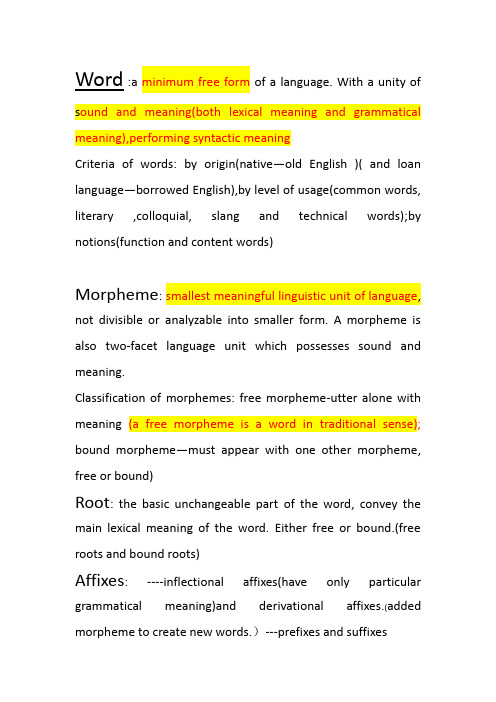
Word :a minimum free form of a language. With a unity of s ound and meaning(both lexical meaning and grammatical meaning),performing syntactic meaningCriteria of words: by origin(native—old English )( and loan language—borrowed English),by level of usage(common words, literary ,colloquial, slang and technical words);by notions(function and content words)Morpheme: smallest meaningful linguistic unit of language, not divisible or analyzable into smaller form. A morpheme is also two-facet language unit which possesses sound and meaning.Classification of morphemes: free morpheme-utter alone with meaning(a free morpheme is a word in traditional sense); bound morpheme—must appear with one other morpheme, free or bound)Root: the basic unchangeable part of the word, convey the main lexical meaning of the word. Either free or bound.(free roots and bound roots)Affixes: ----inflectional affixes(have only particular grammatical meaning)and derivational affixes.(added morpheme to create new words.)---prefixes and suffixesWord-formationThree major processes : compounding(joining tow or more bases to form a new unit of compound words)Derivation(forming a new word by addition of a word element)Conversion(a word of certain word-class is shifted into another word-class without any affixes)Eight minor processes :Acronymy (Initialisms –using the first letter from proper name ,phrase, technical words)Ainitialism is pronounced letter by letter) and acronyms—from the initial letters of the name of an organization or scientific term)==are pronounced as words.Clipping(deletion of one or more syllables from a word—usually a noun, which is also available in its full form)Classification—back clipping, front clipping ,front and back clipping and phrase clipping.)Blending---formed by combining the meanings and sound of tow words.one of which is not full form or both of which are not full form. )不完整拼缀Back-formation(coined by the deletion of a supposed affix from a longer form already present in the language.)Words from proper names(including names of scientists, names of politicians and statesman, names of places, trademark, literature)Reduplication(a compound word is created by the repetition(1)of one word like go-go(2)almost identical words with a change in the vowel’s such as ping-pong.(3)of two almost identical words with a change in the initial consonants ,as in teenyweeny.Neoclassical(new words are formed from elements derived from Latin and Greek)The majority of neoclassical formations are scientific and technical.MiscellaneousWord meaning and sense relations1,conventionality—no way to explain why this or that sound-symbol and its sense.2,motivation—phonetic ,morphological, sematic3,main types of word meaning(interrelated andinterdependent)---class and inflectionalparadigm)andmeaning; connotative meaning—emotional association; social or stylistic meaning and affective meaning)Binary opposites.二相对立Polysemy—a term used in sematic analysis to refer to lexical item which has a range of meanings.)T wo approaches—diachronic and synchronic.---primary meaning and derived meaning, central meaning and secondary meaning(in some cases, the primary meaning and the central meaning coincide.)Two processes leading to polysemy---radiation(each of the secondary meanings may become a center of further radiation),concatenation(linking together, like the links of a chain.Homonymy(---pronounced alike, spell alike, or both.)---types of homonyms(perfect homonyms—word identical in sound and spelling but different in meaning)(Homophones---identical in sound but different in spelling and meaning.)(Homographs—identical in spelling but different in sound and meaning.)Polysemic and homonymous words are stylistically useful to achieve humour or irony, or to heighten dramatic effect. Synonymy(—identical in meaning but different in sound and spelling.)--- Complete synonyms(absolute),Relative synonyms.Antonymy (--opppsiteness of meaning)---contrary, complementary and conversives ….Antonyms classified on the basis of morphological structure: root antonyms and derivational antonyms.Marked and unmarked words---subsume.(Marked members can not be used to include unmarked member.) Hyponymy—(relationship which obtains specific and general lexical items)Superordinate term(an upper term),Subordinate terms(a lower term)===hierarchical system Sematic field---is not simply a listing of independent items, organized into areas or field.Charateristic of the same sematic field.1),word frequency in the same semantic varies 2)these words are semantically interdepent.3) words in the same semantic field are likely to have a number of collocation on common. Changes in word meaning---1,causes:historical,social,foreign influence, linguistic and psychological .2, Four tendencies in sematic change---restriction, extension, degeneration, elevation (of meaning)具体化,普遍化,语义转贬,语义改良。
第1章:现代英语词汇学概论【A general servey of English vocabulary】
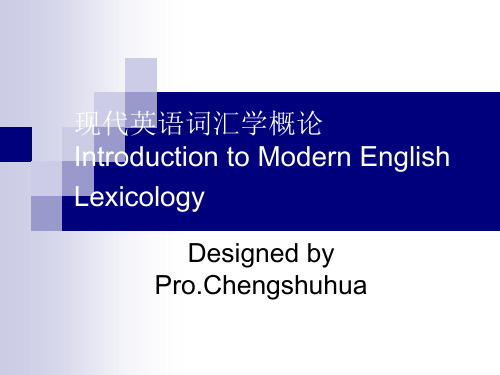
没有上面描述特征的词,不属于语言的正常核 心。它们包括下面:
1.术语Terminology: technical terms used in particular disciplines and academic areas.包括特定学科和学术领域的技术术语,例如在医学 上:光扫描,肝炎,消化不良,青霉素;在数学上:代数,三角学,微积 分;音乐上,交响乐,管弦乐队,奏鸣曲,协奏曲,教育上:视听教学, 自休大学,微型教学等等。 2.行话。Jargon(行话): the specialized vocabularies by which members of particular arts, sciences, trades and professions communicate among themselves.用于特定的词汇,通过特定艺术,科 学,商业和专业领域的成员在彼此之间交流。
1.1一个词是什么?
词语是什么?多年来已经引起了语言学家的关注。争议较大。尽管已 经提出了很多的定义,没有一个是最好的。学者们仍然没有在词语的 定义上达成一致。 当我们谈起一个词语,我们倾向于根据视觉条件来思考。在这个角度, 一个词可以被定义为平印在或者写在纸上的字母的有意义的集合。当 根据口语定义的时候,词被看成是一个发音或发音的集合,是由人的 发音器官自由的发出的。根据语义学家的意见,一个词是一个意义单 位。
——自然现象:雨雪火,水,太阳月亮春夏风山 ——人的身体和亲属:头足手脸父母兄弟姐妹儿子女儿 ——动植物:橡树松树草梨苹果树马牛羊猫狗小鸡 ——动作,尺寸,范围,状态:来去吃听打带好邪恶老年轻 热冷重白黑 ——数词代词介词连接词:一十百我你你的,谁,在里,在 外,在下 等,和但直到如同 这些词不能被英语会话者回避。不能不考虑词源教育专业 地区文化等等。
《现代英语词汇学概论》----解析
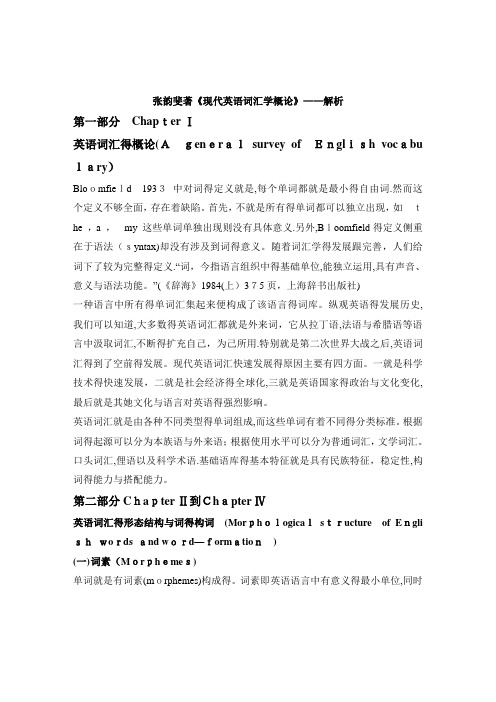
张韵斐著《现代英语词汇学概论》——解析第一部分Chapter Ⅰ英语词汇得概论(Ageneralsurvey ofEnglish vocabu lary)Bloomfield1933中对词得定义就是,每个单词都就是最小得自由词.然而这个定义不够全面,存在着缺陷。
首先,不就是所有得单词都可以独立出现,如the ,a ,my 这些单词单独出现则没有具体意义.另外,Bloomfield得定义侧重在于语法(syntax)却没有涉及到词得意义。
随着词汇学得发展跟完善,人们给词下了较为完整得定义.“词,今指语言组织中得基础单位,能独立运用,具有声音、意义与语法功能。
”(《辞海》1984(上)375页,上海辞书出版社)一种语言中所有得单词汇集起来便构成了该语言得词库。
纵观英语得发展历史,我们可以知道,大多数得英语词汇都就是外来词,它从拉丁语,法语与希腊语等语言中汲取词汇,不断得扩充自己,为己所用.特别就是第二次世界大战之后,英语词汇得到了空前得发展。
现代英语词汇快速发展得原因主要有四方面。
一就是科学技术得快速发展,二就是社会经济得全球化,三就是英语国家得政治与文化变化,最后就是其她文化与语言对英语得强烈影响。
英语词汇就是由各种不同类型得单词组成,而这些单词有着不同得分类标准。
根据词得起源可以分为本族语与外来语;根据使用水平可以分为普通词汇,文学词汇。
口头词汇,俚语以及科学术语.基础语库得基本特征就是具有民族特征,稳定性,构词得能力与搭配能力。
第二部分Chapter Ⅱ到Chapter Ⅳ英语词汇得形态结构与词得构词(Morphologicalstructure of Engli shwords and word—formation)(一)词素(Morphemes)单词就是有词素(morphemes)构成得。
词素即英语语言中有意义得最小单位,同时具有声音与意义.单词可以有一个或一个以上得词素组成。
如:nation就是一个词素,national有nation+al 两个词素。
现代英语词汇学概论--构词法

2) denationalized denationalized = de + nation + al + ize + d Root: nation Stem: denationalize Base: national → nation nationalize → national denationalize → nationalize denationalized → denationalize
Apart from caring for her children, she has to take on such heavy _____ house work as carrying water and firewood. A. time-consumed B. timely-consumed C. time-consuming D. timely-consuming
Compounding / composition: a wordformation process consisting of joining two or more bases to form a new unit. e.g. flowerpot= flower + pot machine-independent = machine + independent back
Root/ 词根: is not further analyzable, either in terms of derivational or inflectional morphology Stem/ 词干: the part of the word-form which remains when all inflectional affixes have been removed. Base/ 词基: any form to which affixes of any kind can be added.
英语词汇学教程夏洋unit2

parking orbits
Medicine: retrovirus, open heart surgery
Atomic technology: fallout, irradiation
现代英语词汇学
7
2) socio-economic, political and cultural changes:
food: fast food, TV dinner, megavitamin, soy milk. Music: disco, punk rock, soul music Television and films: talk shows, boob tube Politics and economy: petropolitics, stagflation Education: open university, tele-quiz Women’s liberation: chairperson, girlcott Drug culture: Mary Jane(marijuana), soft drug现 Nhomakorabea英语词汇学
3
1) 1066, Norman conquest, about 9,000 French words came into English. Three languages- French, English and Latin coexisted for over a century.
(p7.)
现代英语词汇学
6
b) Late modern English
1) Marked progress of science and technology:
Biology
and
